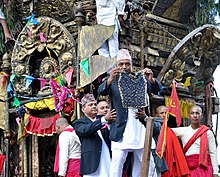Jawalakhel
Jawalakhel
जावलाखेल | |
|---|---|
Urban Subdivision | |
Nepal Time ) |
Jāwalākhel (
Origin of the name
Jawalakhel means "rice throwing field" in
Highlights

Bhoto Jatra is the concluding ceremony of the chariot festival of
The chariots are brought to Jawalakhel for the concluding ceremonies. During Bhoto Jatra, the holy garment "bhoto" is held up from the four sides of the chariot and shown to the enraptured throng that fills the large field.[4]
Jawalakhel is also famed as the home of Central Zoo, the only zoo in the country. It was built by General Maheshwar Shamshere Rana and his team as a private menagerie for Prime Minister Maharaja Juddha Shamshere Rana in 1932. The government was gifted the zoo by Maharaja Juddha when he volunteered to resign from his Prime Ministership, and left as a sanyasi for India. It was opened to the public in 1956.[5] In December 1995, the government handed over responsibility of running the zoo for 30 years to the National Trust for Nature Conservation.[6]
Jawalakhel is the cradle of Nepal's hand-woven woolen carpet industry. In 1960, the government of Nepal, the
In the recent times, Jawalakhel has emerged as one of the most happening places in Lalitpur district with many shopping centres, clothing stores, cafes, restaurants, schools, banks and other modern amenities.
Transportation
Busses of Sajha Yatayat serve Jawalakhel and link it to Kathmandu.[8] Other private Bus companies also stop at several points in the neighborhood.
See also
References
- ISBN 9781440204241.
- ISBN 978-9994611027.
- ^ Vajracharya, Munindraratna (1998). "Karunamaya Jatra in Newar Buddhist Culture". Retrieved 16 February 2014.
- ^ "Bhoto Jatra marked amid much fanfare". The Kathmandu Post. 16 February 2014. Archived from the original on 25 February 2014. Retrieved 23 May 2013.
- ^ "Welcome to Central Zoo". Central Zoo. Archived from the original on 21 February 2014. Retrieved 16 February 2014.
- ^ Central Zoo: The Only Zoo of Nepal Archived 2012-04-15 at the Wayback Machine
- ^ Gurung, Tsering Dolker (10 June 2011). "The rise and fall of the Tibetan carpet industry". Nepali Times. Retrieved 17 February 2014.
- ^ "Route". Sajha Yatayat. Archived from the original on 1 June 2020. Retrieved 20 April 2018.
